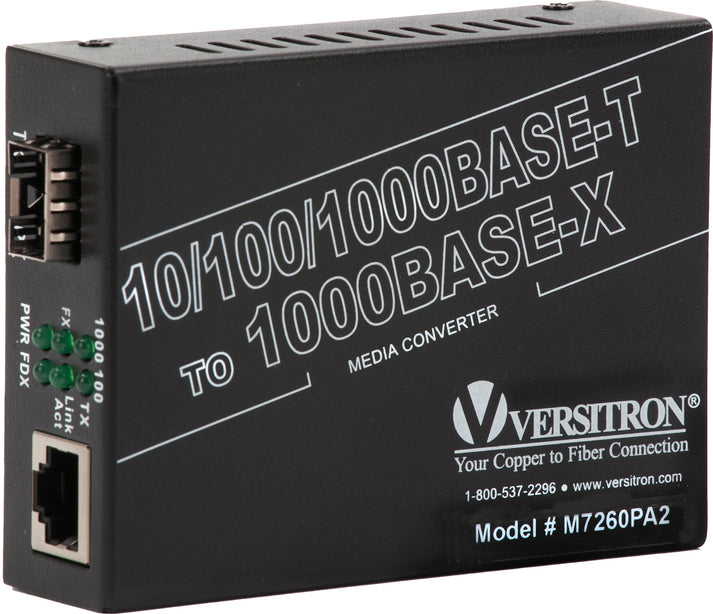
In today's connected world, businesses and industries need robust and efficient solutions to ensure seamless data transmission over long distances. One of the most reliable and cost-effective solutions for network infrastructure is the single fiber media converter. These devices enable the seamless integration of fiber optic and copper-based systems, making them essential for various sectors—from surveillance infrastructure and commercial networks to military fiber optic communications and government fiber optic networks.
What is a Single Fiber Media Converter?
A single fiber optic media converter is a device designed to convert electrical signals into optical signals for transmission over fiber optic cables and vice versa. Unlike traditional converters that use two fibers for sending and receiving, a single fiber WDM media converter uses Wavelength Division Multiplexing (WDM) technology to operate over just one strand. It supports both directions of data flow by assigning different wavelengths to transmit and receive, making it a more efficient and economical solution.
Explore Our Single Fiber Media Converters
Types of Single Fiber Media Converters
- Single Fiber Gigabit Media Converter: Ideal for high-speed environments like enterprise fiber optic networks, data centers, and digital video transmission systems.
- Single Fiber 10/100 Media Converter: Suitable for retail security, educational campuses, and small business Ethernet networks.
- Single Fiber Industrial Media Converter: Built for harsh environments in oil and gas industries, power utilities, and transportation systems.
- Single Fiber Commercial Media Converter: Designed for fiber optic commercial networks and enterprise security.
- Single Fiber Military Media Converter: Crucial for military systems and secure data transmission.
- Single Fiber Government Media Converter: Perfect for government systems and fiber optic network infrastructure.
- Single Fiber PoE Media Converter and Single Fiber PoE+ Media Converter: Power IP security cameras, remote sensor networks, and access control devices.
- Single Fiber Ethernet Media Converter and Single Fiber Optical Media Converter: Ideal for fiber optic Ethernet transport and fiber optic integration.
- Single Fiber Bi-Directional Media Converter and Single Fiber Duplex Media Converter: Used in fiber optic remote monitoring and point-to-point fiber links.
- Available with SFP Port, SC Connector, ST Connector, Auto Negotiation, Auto MDI/MDI-X Detection, Far-End Fault Detection, 128Kb Buffer RAM, and Link Fault Pass-Through.
Applications of Single Fiber Media Converters
1. Surveillance and Security Systems
Use single fiber media converters for surveillance, IP video surveillance, IP cameras, and CCTV systems. They allow fiber optic video transmission, video analytics, security monitoring, and video streaming over long distances with minimal latency and high quality.
2. Military and Government Use
Single fiber media converters for military communications and government networks enable secure data transmission and network fault tolerance. They're used in SCADA networks, smart grid networks, and emergency response systems.
3. Industrial Automation and Smart Cities
Industrial Ethernet networks, manufacturing plants, and transportation systems benefit from single fiber media converters for industrial automation. They’re also central in smart city networks, IoT networks, and environmental monitoring.
4. Data Centers and Enterprise Networks
Deploy single fiber media converters for data centers, fiber optic network scalability, bandwidth management, and network performance optimization. These support fiber optic network redundancy, VLAN, and QoS.
5. Remote Locations and Harsh Environments
A single fiber media converter for harsh environments is critical for remote offices, fiber optic wireless systems, cloud networking, and digital signage where traditional devices would fail.
Key Benefits and Features
- Long-Distance Transmission: With single fiber WDM Ethernet converters, extend network reach across fiber optic WANs, LANs, and backbones.
- Network Resilience: Features like redundant power supply, DIN rail mount, and modular design support fiber optic network uptime and availability.
- PoE Integration: Single fiber PoE+ media converters provide Ethernet over fiber while delivering power to remote endpoints.
- Network Optimization: Enable network diagnostics, fault detection, latency reduction, QoS management, and secure communication protocols.
- Versatility: Support a wide array of fiber optic applications from video conferencing and building automation to digital conversion and packet forwarding.
Conclusion
Whether you’re planning a fiber optic network upgrade, expanding surveillance, or establishing fiber optic communication solutions, single fiber media converters deliver the performance, cost-efficiency, and scalability required for modern networks. With their broad compatibility, robust features, and industry-specific applications, they are the backbone of future-ready fiber optic technology. From enterprise networks to government systems, and from digital transmission to smart city infrastructure, single fiber media converters are paving the way for efficient, secure, and high-speed connectivity.









